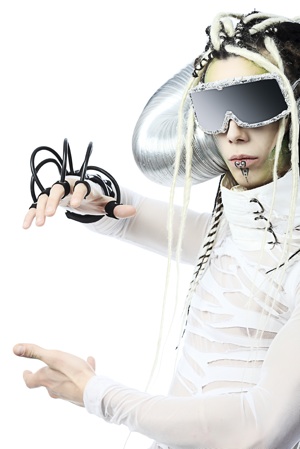A magazine where the digital world meets the real world.
On the web
- Home
- Browse by date
- Browse by topic
- Enter the maze
- Follow our blog
- Follow us on Twitter
- Resources for teachers
- Subscribe
In print
What is cs4fn?
- About us
- Contact us
- Partners
- Privacy and cookies
- Copyright and contributions
- Links to other fun sites
- Complete our questionnaire, give us feedback
Search:
Dressing it up

Even though most robots still walk around naked, The Swedish Institute of Computer Science (SICS) in Stockholm is working to produce fashion conscious robots. The applied computer scientists there are looking for ways to make the robots of today easier for us to get along with. As part of the LIREC project to build the first robot friends for humans (see issue 10) they are examining how our views of simple robots change when we can clothe and customise them. Does this make the robots more believable? Do people want to interact more with a fashionable robot?
How do you want it?
These days most electronic gadgets allow the human user to customise them. For example, on a phone you can change the background wallpaper or colour scheme, the ringtone or how the menus work. The ability of the owner to change the so-called ‘look and feel’ of software is called end-user programming. It’s essentially up to you how your phone looks and what it does.
Dinosaurs waking and sleeping
The team begins by taking current off-the-shelf robots and adding dress-up elements to them. Enter Pleo, a toy dinosaur ‘pet’ able to learn as you play with it. Now add in that fashion twist. What happens when you can play dress up with the dinosaur? Kind of like what happens when you customise your phone, Pleo’s costumes change its behaviour. For example, if you give Pleo a special watchdog necklace the robot remains active and ‘on guard’. Change the costume from necklace to pyjamas, and the robot slowly switches into ‘sleep’ mode. The costumes or accessories you choose communicate electronically with the robot’s program, and its behaviour follows suit in a way you can decide.
Clean sweeps
In another experiment the researchers looked at playing dress up with a robot vacuum cleaner. The cleaner rolls around the house sweeping the floor, and has already proven a hit with many consumers. It bleeps like R2D2 as its on-board computer works out the best path to bust your carpet dust. The SICS team gave the vacuum a special series of stick-on patches, which could add to its basic programming. The right patch can change the way the humans perceive the robot’s actions. Different patches can make humans think the robot is curious, aggressive or nervous. There’s even a shyness patch that makes the robot hide under the sofa.
What’s real?
If humans are to live in a world populated by robots there to help them, the robots need to be able to play by our rules. Humans have whole parts of their brains given over to predicting how other humans will react. For example, we can empathise with others because we know that other beings have thoughts like us, and we can imagine what they think. This often spills over into anthropomorphism, where we give human characteristics to non-human animal or non-living things. Classic examples are where people believe their car has a particular personality, or you think your computer’s being deliberately annoying – they are just machines but our brains tend to attach motives to the behaviours we see.
Real-er robots?
Robots can produce very complex behaviours depending on the situations they are in and the ways we have interacted with them, which creates the illusion that they have some sort of ‘personality’ or motives in the way they are acting. This can help robots seem more natural and able to fit in with the social world around us. It can also improve the ways they can provide us with assistance because they seem that bit more believable. SICS’s actDresses project will help us by providing new ways that the human users can customise the actions of their robots in a very natural way, by getting the robots to dress for the part.


